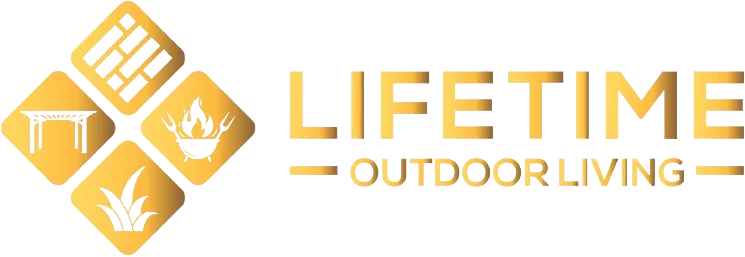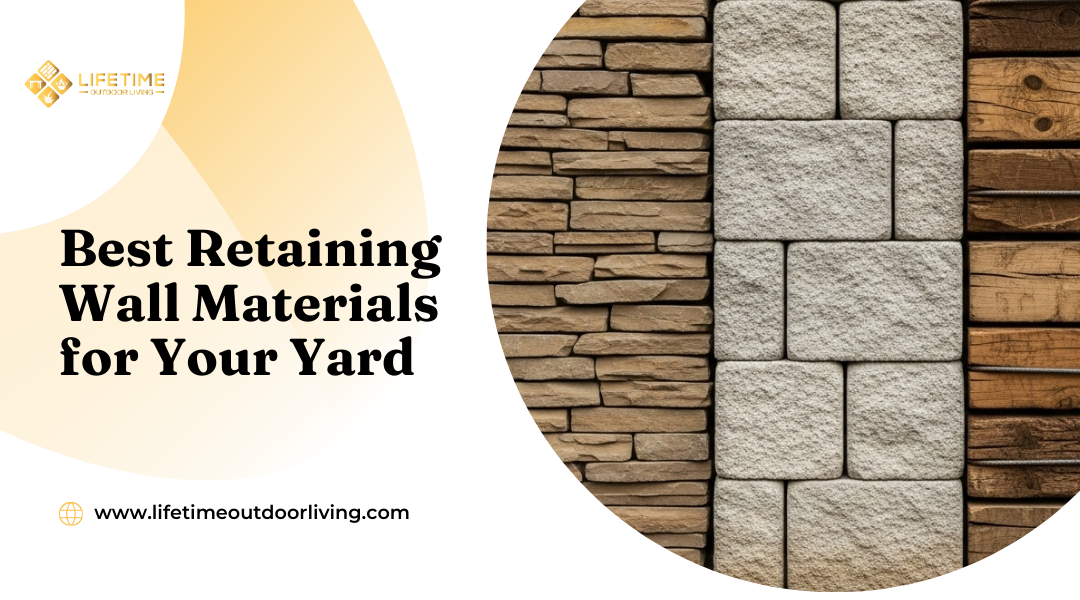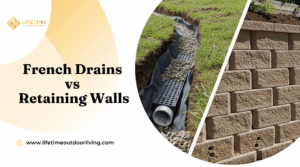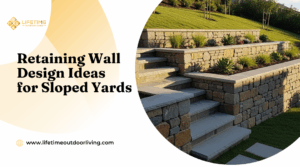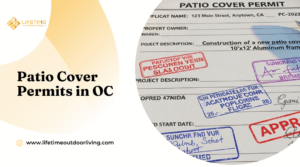Choosing the right retaining wall material shapes both the look and performance of your yard. The best material for your retaining wall depends on your soil conditions, wall height, drainage needs, and the overall style you want to achieve. Whether you prefer the clean lines of concrete blocks, the natural character of stone, or the warmth of timber, each option brings its own strengths and limitations.
By understanding how different materials handle weight, water, and long-term wear, you can make a choice that balances durability with design. A well-built retaining wall not only prevents erosion and manages slopes but also adds usable space and visual appeal to your outdoor area.
At Lifetime Outdoor Living in Laguna Beach, you gain access to expert guidance and high-quality installation that ensures your wall is both functional and attractive. With the right material and professional craftsmanship, your retaining wall becomes a lasting feature that enhances the value and usability of your property.
Why Choosing The Right Retaining Wall Material Matters
The material you select for your retaining wall directly affects how well it holds soil, how long it lasts, how it looks in your yard, and how much upkeep it requires. Local climate, soil type, and budget also play a major role in determining the most practical choice for your project.
Balancing Function, Durability, And Aesthetics
A retaining wall must do more than look attractive—it needs to withstand soil pressure and resist erosion. Materials like concrete blocks provide strong structural support, while natural stone offers long-term durability with a more organic appearance.
You also need to consider how the wall blends with your landscape. For example, stone complements natural surroundings, while concrete can be finished in modern styles. Timber gives a warm, rustic feel but typically has a shorter lifespan compared to stone or concrete.
Durability often comes down to resistance against weathering and soil movement. Concrete and stone usually last decades with minimal issues, while wood may require replacement after 15–25 years. Choosing a balance between strength and style ensures your wall is both functional and visually appealing.
Considering Orange County Climate And Soil Conditions
Laguna Beach and surrounding areas experience mild, coastal weather with occasional heavy rains. The combination of clay soils in some neighborhoods and sloped terrain means retaining walls must handle both water drainage and soil expansion.
Materials with good drainage properties, such as gabions or properly designed concrete block systems, reduce water pressure behind the wall. Stone also performs well because it allows some natural water movement. Timber, however, is more vulnerable to moisture and pests in this environment.
Salt air from the ocean can also affect materials. Reinforced concrete and treated stone resist corrosion better than untreated metal or low-grade wood. By factoring in local conditions, you ensure the wall remains stable and requires fewer repairs over time.
Cost And Long-Term Maintenance Factors
Your budget should account for both initial installation and ongoing upkeep. Concrete blocks and gabions may cost more upfront but usually require little maintenance. Natural stone is also low-maintenance but comes with higher labor costs due to its weight and installation complexity.
In contrast, treated timber is more affordable initially but often needs replacement or repairs within a couple of decades. It may also require sealing or pest treatments over time.
When comparing costs, think in terms of lifespan:
- Concrete: 40–50+ years with minimal upkeep
- Stone: 50+ years, very low maintenance
- Timber: 15–25 years, higher upkeep
Factoring in long-term expenses helps you choose a material that fits your budget now and reduces costly replacements later.
Popular Retaining Wall Material Options
Each retaining wall material offers different strengths, costs, and design possibilities. Your choice depends on factors like durability, maintenance needs, installation method, and how well the material fits with your landscape style.
Concrete Blocks
Concrete blocks are a common choice for residential retaining walls because they balance cost, strength, and ease of installation. Interlocking systems allow you to stack blocks without mortar, making them suitable for DIY projects under four feet tall.
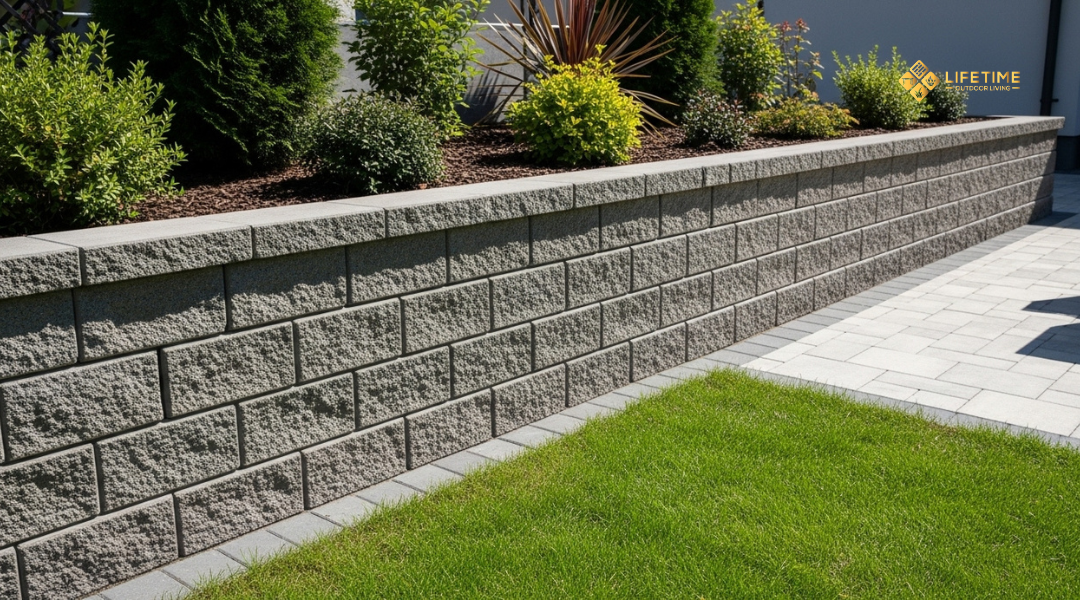
These blocks come in a range of colors, textures, and face finishes, so you can match them with patios, walkways, or other hardscaping elements. They work well for both straight and curved walls.
For stability, you need a compacted crushed stone base and sometimes geogrid reinforcement for taller walls. Maintenance is minimal beyond occasional cleaning and checking for shifting.
Typical cost: $10–$15 per square foot (materials only).
Poured Concrete
Poured concrete walls provide the greatest structural strength and are well-suited for high walls or areas with heavy soil pressure. Unlike block systems, these walls are cast as a single solid structure, which reduces weak points.
You can customize the surface with stains, textured forms, or stone veneers to avoid a plain gray look. This makes poured concrete flexible for modern or traditional landscapes.
Because of the need for reinforced footings, formwork, and proper drainage, you almost always need professional installation. Once built, these walls require little upkeep aside from monitoring for cracks.
Typical cost: $8–$12 per square foot (materials only).
Natural Stone
Natural stone offers a timeless look and blends seamlessly into landscapes with a rustic or organic style. Fieldstone, granite, and limestone are popular options, each with unique textures and colors.
Walls can be built as mortared or dry-stacked. Dry-stacked walls rely on careful placement and gravity, while mortared walls use concrete footings and mortar joints for added strength.
Stone walls are labor-intensive and usually require skilled masons, but they can last for decades with proper drainage. They also tend to be more expensive due to material and installation costs.
Typical cost: $25–$40 per square foot (materials only).
Brick Retaining Walls
Brick retaining walls provide a clean, uniform appearance and work well in traditional or formal landscapes. They are typically built with mortar over a reinforced concrete footing, which ensures long-term stability.
You can choose between different brick colors, textures, and laying patterns to complement your home’s exterior. Brick also pairs well with walkways, driveways, and garden edging.
These walls are durable but require careful drainage planning to prevent water buildup behind them. Over time, mortar joints may need repointing to maintain strength and appearance.
Typical cost: $20–$30 per square foot (materials only).
Timber/Wood Retaining Walls
Timber retaining walls are popular for smaller projects because they are affordable and relatively easy to install. Pressure-treated pine and fir are common choices, while cedar and redwood offer natural resistance to rot.
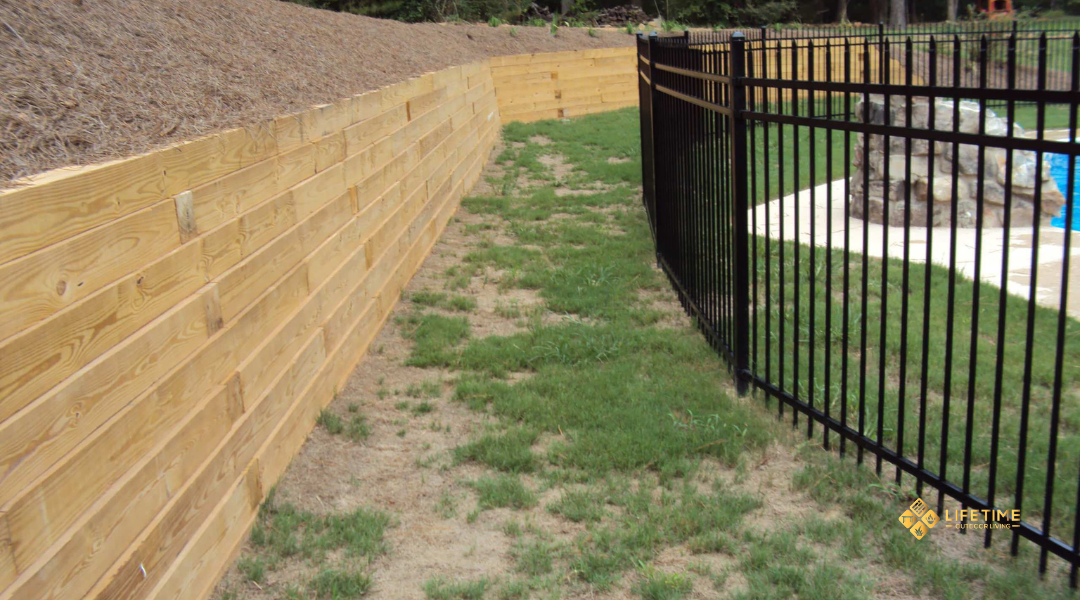
Wood walls typically use large timbers anchored with deadmen or rebar, supported by a gravel base for drainage. They can be built with curves or angles to fit your yard’s layout.
The main drawback is lifespan. Even treated wood will eventually deteriorate, usually lasting 15–40 years depending on soil conditions and climate. Regular inspection helps extend their service life.
Typical cost: $15–$25 per square foot (materials only).
Gabion Walls
Gabion walls use wire mesh cages filled with stone or recycled concrete. They create a rugged, industrial look and are highly effective at managing soil pressure and drainage.
You can stack gabion baskets in tiers, making them suitable for sloped properties. The stone fill allows water to pass through freely, which reduces the risk of hydrostatic pressure behind the wall.
They require less precision in construction compared to masonry, but the wire mesh can corrode over time if not galvanized or coated. Gabion walls often work best in modern or naturalistic landscapes.
Typical cost: $5–$15 per square foot (materials only).
Comparing Retaining Wall Materials: Pros And Cons
When you choose a retaining wall, the material affects how long it lasts, how much it costs, how much upkeep it needs, and how it looks in your yard. Each option has trade-offs that make it more or less suitable depending on your priorities.
Durability And Lifespan
Concrete block and poured concrete walls provide strong structural support and can last several decades with proper installation. They resist shifting soil and heavy loads, making them reliable for taller or more demanding walls.
Natural stone also offers excellent durability. Granite and limestone can withstand weathering and erosion for generations, while fieldstone and boulders provide strength but may require skilled placement.
Wood, even when pressure-treated, has the shortest lifespan. Exposure to moisture and insects eventually causes decay, usually within 10–20 years. Brick falls somewhere in the middle, offering good longevity but requiring solid construction to prevent cracking.
If you want the longest-lasting option, stone and reinforced concrete are the most dependable choices, while timber works best for shorter-term or budget-friendly projects.
Cost Range And Budget Fit
Timber is typically the lowest-cost option, making it appealing if you want an affordable solution. However, you should factor in the shorter lifespan and potential replacement costs.
Concrete blocks offer a balance of price and performance. Standard CMUs are cost-effective, while decorative segmental blocks or textured finishes increase the price but improve appearance. Poured concrete usually costs more upfront due to labor and reinforcement requirements.
Natural stone is often the most expensive. Cut stone and boulders require higher material and installation costs, especially if heavy equipment is needed. Brick walls also lean toward the higher end of the cost range due to labor-intensive construction.
You should match the material to your budget not only for installation but also for long-term value. A higher initial cost may pay off if the wall lasts decades without replacement.
Maintenance Requirements
Concrete walls need little maintenance beyond occasional sealing to prevent moisture absorption or cracking. Segmental blocks with interlocking designs also perform well with minimal upkeep.
Natural stone requires little attention once installed, though mortar joints in some designs may need repair over time. Boulders and dry-stacked stone are especially low-maintenance because they allow natural drainage.
Wood requires the most care. Even treated lumber benefits from sealing or staining to slow down rot and insect damage. You may also need to replace boards or sections sooner than with other materials.
Brick walls hold color well but may require repointing of mortar joints to maintain stability. Regular inspection helps prevent small issues from becoming costly repairs.
Design Flexibility And Visual Impact
Concrete blocks offer multiple styles, from plain gray units to textured or colored finishes that resemble stone. Segmental systems provide consistent shapes, making them versatile for curved or tiered walls.
Poured concrete can be molded into custom forms and finished with smooth, stamped, or stained surfaces. This makes it suitable for modern designs or projects requiring exact shapes.
Natural stone creates a more organic look. Fieldstone and boulders blend into landscapes naturally, while cut stone provides a refined, formal appearance. The irregularity of stone gives each wall a unique character.
Timber provides a warm, rustic look that works well in natural settings. Brick delivers a traditional aesthetic that pairs well with certain architectural styles but is less adaptable to irregular layouts.
Your choice depends on whether you prefer a natural, modern, or classic look, as each material offers distinct visual qualities.
Factors To Consider Before Choosing A Material
The right retaining wall material depends on the conditions of your yard, how water moves through the soil, how the wall fits with other outdoor features, and the design rules in your community. Each factor can affect both the durability and appearance of the finished structure.
Yard Slope And Soil Type
The slope of your yard directly influences how much pressure a retaining wall must withstand. Steeper slopes create higher loads, which means you need stronger materials like concrete block or reinforced stone. Gentle slopes may allow lighter options such as timber or smaller modular blocks.
Soil type matters just as much. Clay soils hold water and expand, which adds stress to the wall. Sandy or loose soils drain quickly but may shift, requiring deeper footings or geogrid reinforcement.
If your yard combines steep grades with heavy clay, you should choose a material that can handle both weight and moisture. In many Laguna Beach properties, soils vary within short distances, so testing or professional evaluation is often necessary before finalizing a material.
Drainage Needs And Erosion Control
Water buildup behind a retaining wall is one of the most common causes of failure. Without proper drainage, even strong materials can crack, lean, or collapse. You need to plan for gravel backfill, perforated drain pipes, or weep holes depending on the wall height and soil conditions.
Materials also respond differently to moisture. Concrete block and natural stone resist water damage well, while untreated timber can rot in damp conditions. If your yard experiences heavy seasonal rain, prioritize materials that work well with drainage systems and won’t degrade when exposed to moisture.
Erosion control is another factor. On sloped sites, runoff can wash away soil near the base of the wall. Choosing a material with enough weight, combined with proper grading, helps stabilize the area.
Integration With Pavers, Turf, Or Other Hardscaping Features
Retaining walls rarely stand alone. They often connect with patios, walkways, turf areas, or planters. When choosing a material, consider how it will coordinate with these features in both style and function.
For example:
- Concrete block pairs well with modern pavers and offers consistent color.
- Natural stone blends with turf and garden areas for a more organic look.
- Brick can complement traditional patios or pathways.
Matching textures and colors helps create a unified outdoor space. Beyond appearance, you also need to think about transitions. A wall that borders a patio should align with the paving height, while a wall near turf should allow for smooth mowing edges.
HOA And Local Design Guidelines In Orange County
In Laguna Beach and other parts of Orange County, many neighborhoods fall under HOA rules or city design guidelines. These can limit the height of retaining walls, dictate approved materials, or require specific colors and finishes.
Before selecting a material, review your HOA handbook or contact the city planning department. Some associations discourage timber due to maintenance concerns, while others may prefer stone or masonry for consistency across properties.
Permitting is also a factor. Walls above a certain height often require engineering approval, and some materials may need additional structural design. By confirming requirements early, you avoid costly changes later and ensure your retaining wall meets both aesthetic and safety standards.
Professional Vs. DIY Retaining Wall Installation
Building a retaining wall requires more than stacking blocks. You need to consider soil pressure, drainage systems, and long-term durability to ensure the structure holds up in changing conditions. The decision between doing the work yourself or hiring a professional affects both safety and the lifespan of the wall.
Challenges Of DIY (Safety, Drainage, Structural Integrity)
When you take on a retaining wall project yourself, you face several technical challenges. Safety risks are common, especially when moving heavy blocks or cutting stone. Without proper equipment, you increase the chance of injury.
Drainage is another concern. A wall without adequate gravel backfill, perforated piping, or weep holes will trap water. This pressure often leads to bulging or collapse. Many DIY walls fail because drainage details get overlooked.
Structural integrity depends on correct engineering. Taller walls usually need geogrid reinforcement, buried base courses, and compacted backfill. If you skip these steps, the wall may lean or crack over time.
A small garden border wall may be manageable as a DIY task, but once the wall exceeds a few feet in height, the risks and complexity increase significantly.
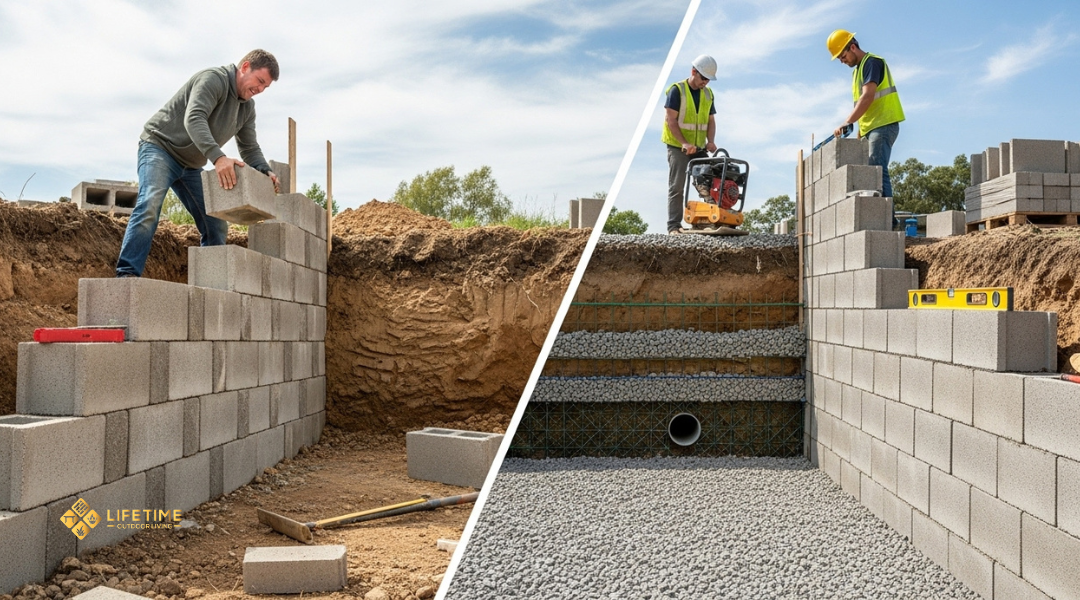
Benefits Of Hiring Lifetime Outdoor Living In Laguna Beach
Working with Lifetime Outdoor Living gives you access to professional design, engineering, and installation. Your wall will meet local building codes and withstand soil pressure, heavy rainfall, and coastal conditions common in Laguna Beach.
Professionals handle excavation, drainage systems, and material selection. You avoid costly mistakes like improper base preparation or insufficient reinforcement. The team uses specialized tools and proven methods that ensure long-term stability.
Hiring experts also saves you time. What could take weeks on your own can often be completed in a fraction of the time with a professional crew. This efficiency reduces disruption to your yard and ensures a clean, finished look.
With a contractor, you also gain a warranty on workmanship. If issues arise, you have support to address them quickly, giving you confidence in the investment.
